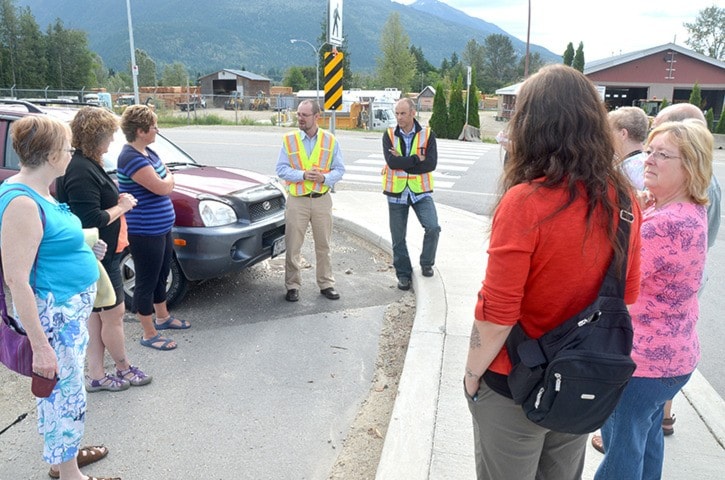It’s gagging strong. That’s how Southside residents described the sewer odour wafting from the sewage treatment lagoons located between Southside and the industrial park.
After 15 years of complaining, they’re fed up and want something done about it.
About a dozen attended an impromptu rally at the City of Revelstoke’s public works facility on Aug. 19, where they met with city engineering director Mike Thomas and public works operations manager Darren Komonoski.
Mom Beckie Campbell lives in the Oscar Street trailer park. She helped organize the gathering. She worries about the health of her toddler Hailey.
“It’s years of frustration building up and nothing’s changing. It’s the health effects I’m worried about. My kids grew up there. I’ve got a two-year-old – she [can’t] be out at night. It’s terrible. We can’t open our windows to cool off our houses,” Campbell told Thomas and Komonoski.
Others said they couldn’t hang their laundry or barbecue when the stink wells up in the summer.
Many said they’d complained to city hall many times, but were essentially dismissed by city officials.
In 2010/11, Campbell went door-to-door in Southside with a petition, gathering support for the cause from residents eager to affect change. She completed it and dropped it off at city hall.
The response? Nothing. She didn’t get a call-back, or hear anything from city staff or city council, she said. Her efforts were dismissed.
Anger and frustration were the undertone of the meeting; residents wondered why the situation couldn’t be managed better.
City engineering director Mike Thomas said staff were exploring some new, improved treatment options. He said he’d done testing in the past few weeks, and had just received the results. The issue, said Thomas, is diagnosing exactly what the problem is – down to determining exactly where the smell comes from.
Does it come from the organic treatment lagoon? Or is the smell coming from the head-works?
Thomas said some improvements are possible, but an understanding of exactly what the problem is is critical.
(story continues below photo)

PHOTO: Mom Beckie Campbell is concerned about the possible health effects of the Southside sewer stench on her daughter Hailey. The odour is so powerful, outdoor time is restricted and windows must be closed even on hot days. Aaron Orlando/Revelstoke Times Review
“It’s not going to be simple,” Thomas said.
The existing system is not mechanical. It relies on biological processes to break down waste. When summer heat sets in, it affects the beneficial bacteria’s ability to process the waste effectively. Other biological processes come into play, creating hydrogen sulphide gas, which causes the smell. Even extremely minuscule concentrations of the gas cause a bad odour. Thomas said the system can’t be “ramped up” quickly to deal with smell issues when they crop up.
The engineering director said the study of the system would explore many treatment options, including treatment system tweaks or pre-treatment methods. For example, oil and fat dumped down the drain can cause significant smell issues. Thomas said stepping up inspections of fat-traps at restaurants could be an option.
Another area of study is the effects of allowing sani-dump waste into the system.
Residents questioned whether allowing more effluent from the Revelstoke Mountain Resort area into the system was a contributing factor. Both Thomas and Komonoski said it wasn’t.
Thomas again emphasized a correct diagnosis is key. “I want to make sure it is going to work before we go out and spend taxpayers’ dollars,” he told the crowd. “Hopefully we can get something in by this time next year.”
Residents also discussed next steps. The temporary treatment will require a budget allocation – the cost has yet to be determined. That spending will require political support. The protesters talked of taking the issue to a city council meeting, although they also said their phone calls, petitions and letters had been brushed off in the past.
Campbell wondered why the mayor and council hadn’t tackled the problem. “How can you live in a town this small and not know there’s an issue?” she asked.
Currently, the sewage lagoon drains into the Illecillewaet River. A new outfall at the Columbia River has been planned for years, but is held up due to cost. However, Thomas said the new outfall will not improve the smell situation at the lagoon.
Installing a “mechanical” lagoon is another option – but an extremely expensive one. Thomas said the cost is in the tens of millions.
“Why not?” quipped one resident. “Our taxes are high enough!”
Thomas and Komonoski said they heard about the gathering through social media, and took the initiative to attend.
No city councillors showed up for the meeting.
